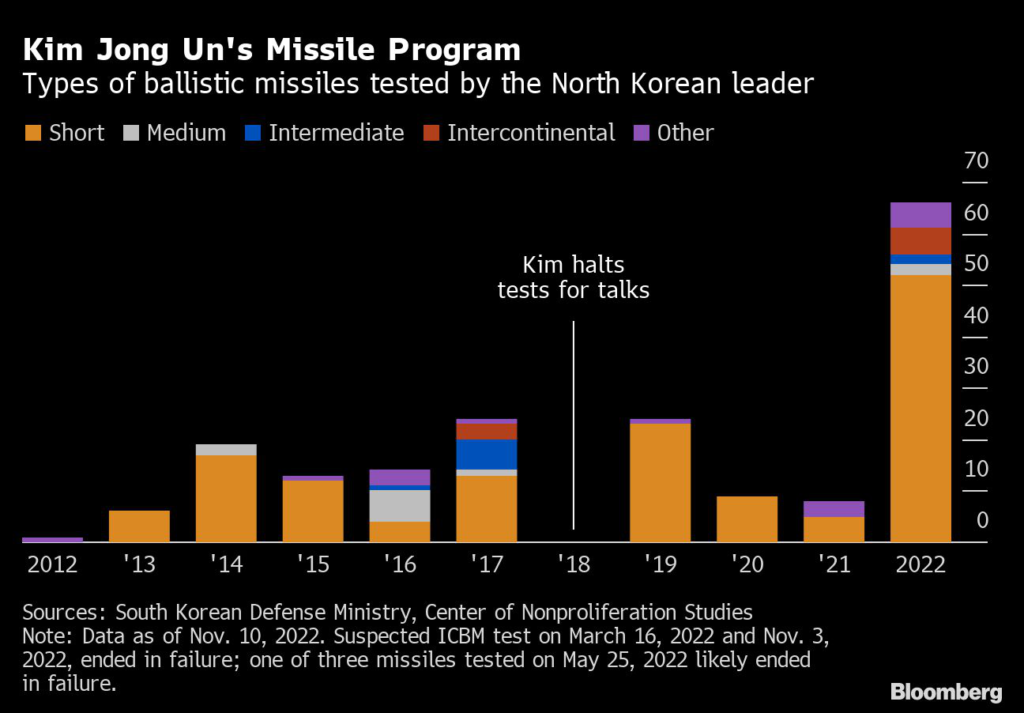North Korean leader Kim Jong Un oversaw the test of a new solid-fuel rocket engine that could enhance the state’s ability to fire off quick-strike, longer-range missiles for delivering nuclear warheads.
(Bloomberg) — North Korean leader Kim Jong Un oversaw the test of a new solid-fuel rocket engine that could enhance the state’s ability to fire off quick-strike, longer-range missiles for delivering nuclear warheads.
State media on Friday said Kim “guided the important test” of a “high-thrust solid-fuel motor,” noting its was the first of its kind for the country. “This important test has provided a sure sci-tech guarantee for the development of another new-type strategic weapon system,” the official Korean Central News Agency reported.
It also released photos of Kim, with cigarette in hand, smiling in front of a massive cloud of smoke from the test site at its Sohae Satellite Launching Ground, along with other shots showing flames shooting out from the place where it said the engine test took place.
“This is the largest solid fuel motor test ever conducted by North Korea,” said David Schmerler, a senior research associate at the James Martin Center for Nonproliferation Studies with the Middlebury Institute of International Studies at Monterey.
Solid-fuel missiles are quick to deploy and can be easier to hide, giving the US and its allies less time to see signs of a launch and prepare interceptors. Kim has been modernizing his missile arsenal over the past several years, and has rolled out new, nuclear-capable, short-range ballistic missiles that can hit US military bases in all of South Korea and parts of Japan.
“Solid fuel missiles require less preparation prior to launching as they are built with the fuel ‘baked’ into the missile body. Shorter launch times ultimately increase the survivability of the system,” Schmerler said.
The engine could be used for its Pukguksong series of submarine-launched ballistic missiles — a two-stage, nuclear-capable rocket that has a range to hit all of Japan. It could also be used for longer-range missiles, including possible intercontinental ballistic ones that could deliver a nuclear warhead to the US mainland.
The size of the rocket motor, with an estimated diameter of 2.1 meters, is larger than a 1.7-meter diameter motor used in the first stage of a US Minuteman-1 ICBM, according to George William Herbert, an adjunct professor at the Center for Nonproliferation Studies.
North Korea is steadily moving toward larger and more capable missiles that are “more portable and easier and faster to fire,” Herbert said. Pyongyang is continuing a rapid development of a program that employs significant portions of the state’s available national resources, he added.
“We aren’t going to like the implications and capabilities they’re demonstrating now,” he said in an email. “They’re good engineers and designers, and moving very quickly through advanced development towards a modern nuclear deterrent and possibly nuclear warfighting force.”
North Korea’s current ICBMs use liquid-fuel engines, which take longer to prepare and give the US and its allies a greater chance to shoot them down on the launch pad than would be the case with a potential solid-fuel version.
This year, Kim’s regime has fired off more than 65 ballistic missiles, the most during his decade in power and in defiance of United Nations resolutions that bar the launches. He has stepped up the provocations in recent weeks in a display of anger at joint military drills in the region conducted by the US and its allies South Korea and Japan.
The US, Japan and South Korea have warned that Pyongyang could soon raise tensions even higher with a nuclear test, which would be its first in five years and seventh overall.
The US push to isolate Russia over Vladimir Putin’s war in Ukraine, coupled with increasing animosity toward China, has allowed Kim to strengthen his nuclear deterrent without fear of facing more sanctions at the UN Security Council. There’s almost no chance Russia or China, which have veto power at the council, would support any measures against North Korea, as they did in 2017 following a series of weapons tests that prompted former President Donald Trump to warn of “fire and fury.”
(Updates with comments from specialist.)
More stories like this are available on bloomberg.com
©2022 Bloomberg L.P.











